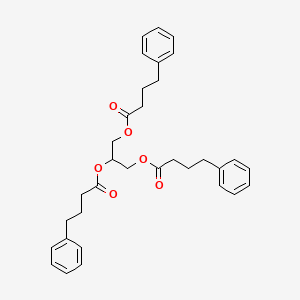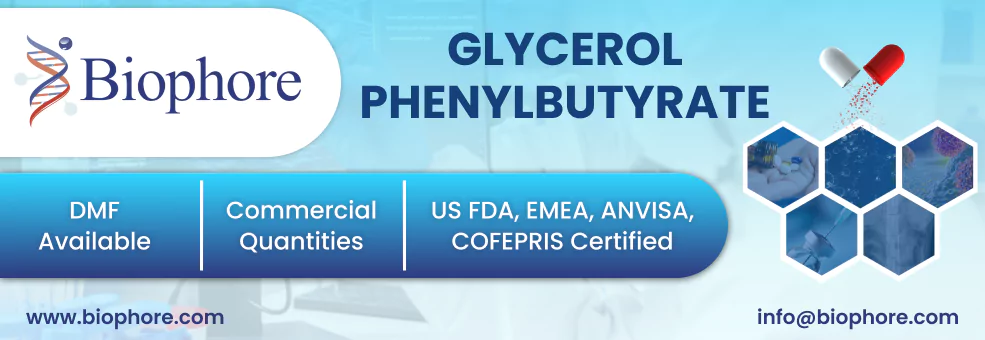



1. Hpn 100
2. Hpn-100
3. Hpn100
4. Ravicti
1. 611168-24-2
2. Ravicti
3. Hpn-100
4. Glycerolphenylbutyrate
5. Gt4p
6. Hpn100
7. Propane-1,2,3-triyl Tris(4-phenylbutanoate)
8. Zh6f1vcv7b
9. Glycerol Phenylbutyrate [usan]
10. Glycerol Phenylbutyrate (usan)
11. Benzenebutanoic Acid, 1,1',1''-(1,2,3-propanetriyl) Ester
12. Unii-zh6f1vcv7b
13. Tris(4-phenylbutyryl)glycerol
14. Glyceryl Tri-4-phenylbutyrate
15. Glyceryl Tri-(4-phenylbutyrate)
16. Hpn 100
17. Glycerol Phenylbutyrate [usan:inn]
18. Ravicti (tn)
19. Glycerol-phenylbutyrate
20. 2,3-bis(4-phenylbutanoyloxy)propyl 4-phenylbutanoate
21. Chembl2105745
22. Schembl10102804
23. Dtxsid40210005
24. Hpn-100hpn-100
25. Chebi:134745
26. Hy-b2087
27. Glycerol Phenylbutyrate [mi]
28. Tri(4-phenylbutyryl)glycerol
29. Glycerol Phenylbutyrate [inn]
30. S6981
31. Glyceryl Tri(4-phenylbutyrate)
32. At33615
33. Db08909
34. Glycerol Phenylbutyrate [vandf]
35. Glycerol Phenylbutyrate [who-dd]
36. Glyceryl Tri (4-phenylbutyrate)
37. Cs-0017499
38. Glycerol Phenylbutyrate [orange Book]
39. D10127
40. Q15322709
41. Benzenebutanoic Acid, 1,2,3-propanetriyl Ester
| Molecular Weight | 530.6 g/mol |
|---|---|
| Molecular Formula | C33H38O6 |
| XLogP3 | 6.7 |
| Hydrogen Bond Donor Count | 0 |
| Hydrogen Bond Acceptor Count | 6 |
| Rotatable Bond Count | 20 |
| Exact Mass | 530.26683893 g/mol |
| Monoisotopic Mass | 530.26683893 g/mol |
| Topological Polar Surface Area | 78.9 Ų |
| Heavy Atom Count | 39 |
| Formal Charge | 0 |
| Complexity | 648 |
| Isotope Atom Count | 0 |
| Defined Atom Stereocenter Count | 0 |
| Undefined Atom Stereocenter Count | 0 |
| Defined Bond Stereocenter Count | 0 |
| Undefined Bond Stereocenter Count | 0 |
| Covalently Bonded Unit Count | 1 |
| 1 of 2 | |
|---|---|
| Drug Name | Ravicti |
| PubMed Health | Glycerol Phenylbutyrate (By mouth) |
| Drug Classes | Hyperammonemia Agent |
| Drug Label | RAVICTI (glycerol phenylbutyrate) is a clear, colorless to pale yellow oral liquid. It is insoluble in water and most organic solvents, and it is soluble in dimethylsulfoxide (DMSO) and >65% acetonitrile.Glycerol phenylbutyrate is a nitrogen-binding... |
| Active Ingredient | Glycerol phenylbutyrate |
| Dosage Form | Liquid |
| Route | Oral |
| Strength | 1.1gm/ml |
| Market Status | Prescription |
| Company | Hyperion Therap |
| 2 of 2 | |
|---|---|
| Drug Name | Ravicti |
| PubMed Health | Glycerol Phenylbutyrate (By mouth) |
| Drug Classes | Hyperammonemia Agent |
| Drug Label | RAVICTI (glycerol phenylbutyrate) is a clear, colorless to pale yellow oral liquid. It is insoluble in water and most organic solvents, and it is soluble in dimethylsulfoxide (DMSO) and >65% acetonitrile.Glycerol phenylbutyrate is a nitrogen-binding... |
| Active Ingredient | Glycerol phenylbutyrate |
| Dosage Form | Liquid |
| Route | Oral |
| Strength | 1.1gm/ml |
| Market Status | Prescription |
| Company | Hyperion Therap |
Glycerol phenylbutyrate is a nitrogen-binding agent for the chronic management of adult and pediatric patients 2 years of age with urea cycle disorders (UCDs) who cannot be managed by dietary protein restriction and/or amino acid supplementation alone.
FDA Label
Ravicti is indicated for use as adjunctive therapy for chronic management of patients with urea cycle disorders (UCDs) including deficiencies of carbamoyl phosphate-synthase-I (CPS), ornithine carbamoyltransferase (OTC), argininosuccinate synthetase (ASS), argininosuccinate lyase (ASL), arginase I (ARG) and ornithine translocase deficiency hyperornithinaemia-hyperammonaemia homocitrullinuria syndrome (HHH) who cannot be managed by dietary protein restriction and/or amino acid supplementation alone.
Ravicti must be used with dietary protein restriction and, in some cases, dietary supplements (e. g. , essential amino acids, arginine, citrulline, protein-free calorie supplements).
Glycerol phenylbutyrate prolongs the QTc interval.
A16AX09
A - Alimentary tract and metabolism
A16 - Other alimentary tract and metabolism products
A16A - Other alimentary tract and metabolism products
A16AX - Various alimentary tract and metabolism products
A16AX09 - Glycerol phenylbutyrate
Absorption
Glycerol phenylbutyrate is a prodrug in which phenylbutyrate (PBA) is released from the glycerol backbone by lipases in the gastrointestinal tract. PBA then undergoes beta-oxidtion to form PAA. When a single oral dose of 2.9 mL/m2 of Glycerol phenylbutyrate is given to fasting adult subjects, the pharmacokinetic parameters are as follows: Tmax: PBA = 2 hours; PAA = 4 hours; PAGN = 4 hours. Cmax: PBA = 37.0 g/mL; PAA = 14.9 g/mL; PAGN = 30.2 g/mL. In healthy subjects, the hydrolysis of glycerol phenylbutyrate is incomplete, but to what extent is unknown. When glycerol phenylbutyrate is given to adult UCD patients, maximum plasma concentrations at steady state (Cmaxss) of PBA, PAA, and PAGN occurred at 8 h, 12 h, and 10 h, respectively, after the first dose in the day. Intact glycerol phenylbutyrate was not detectable in plasma in UCD patients.
Route of Elimination
Glycerol phenylbutyrate is mainly excreted as PAGN in the urine (68.9% in adults and 66.5% in pediatric UCD patients). PAA and PBA represented minor urinary metabolites, each accounting for <1% of the administered dose of PBA.
Pancreatic lipases hydrolyze glycerol phenylbutyrate to release PBA from the glycerol backbone. PBA undergoes -oxidation to PAA, which is conjugated with glutamine in the liver and in the kidney through the enzyme phenylacetyl-CoA: L-glutamine-N-acetyltransferase to form PAGN.
The toxic accumulation of ammonia in the blood and brain arise from urea cycle disorders in which patients are deficient in critical enzymes or transporters that are involved in the synthesis of urea from ammonia. Glycerol phenylbutyrate is a prodrug - the major metabolite, phenylacetate (PAA) is the molecule that binds to nitrogen. PAA conjugates with glutamine (which contains 2 molecules of nitrogen) via acetylation in the liver and kidneys to form phenylacetylglutamine (PAGN), which is excreted by the kidneys. PAGN, like urea, contains 2 moles of nitrogen and provides an alternate vehicle for waste nitrogen excretion.
